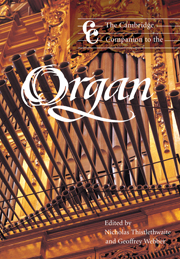7 - The fundamentals of organ playing
from Part II - The player
Published online by Cambridge University Press: 28 September 2011
Summary
There is nothing remarkable about it. All one has to do is hit the right notes at the right time, and the instrument plays itself.
(Comment attributed to Bach by J. F. Köhler, Historia Scholarum Lipsiensium, p. 94; cited in Spitta 1880 ii: 744)J. S. Bach's modest response to compliments on his organ playing is perhaps the most authoritative and succinct account of that art. However, playing ‘the right notes at the right time’ on the organ is more complicated than it may at first appear. Although organists do not produce the tone of their instrument and are unable to create variations of dynamics and timbre through touch, crafting a musical line from the static quality of organ sound demands an extremely sensitive approach to articulation and to timing the notes that make a musical phrase. The art of playing the organ resides almost exclusively in articulation and timing; these nuances are what distinguishes the organist's technique of touch from that of typists and stenographers, who are also concerned with striking the right keys. For the latter, the way the keys are depressed and released matters little as long as the text is captured in print as quickly as possible. In order to make music on the organ, however, a mechanical approach to accuracy is insufficient; the organist must cultivate different ways of depressing and releasing keys to create the musical nuances possible in other instruments where the tone is produced by the player.
The dynamic stability of the organ makes it ideal for the performance of counterpoint since each line is heard at approximately the same loudness and timbre throughout the compass of any combination of stops. It is not surprising that the instrument’s most cherished repertoire is contrapuntal, because the independence of the parts is brought out by the uniformity of organ tone. The player’s task is to articulate each line of polyphony so that it can be heard clearly, even in reverberant acoustical settings.
- Type
- Chapter
- Information
- The Cambridge Companion to the Organ , pp. 93 - 112Publisher: Cambridge University PressPrint publication year: 1999



